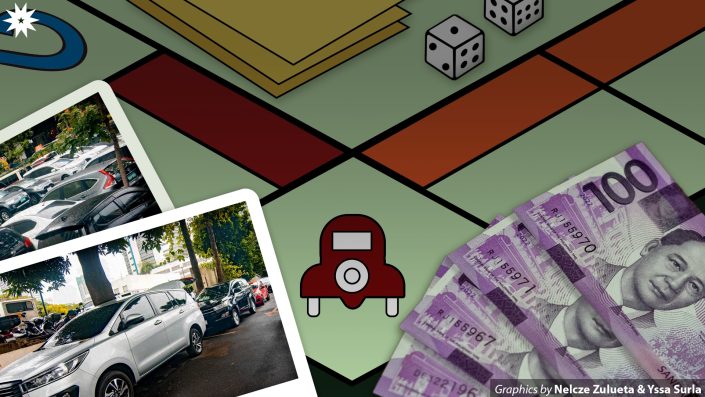In 2020, a Help Desk Announcement said that an increase of parking fees will be implemented in the Enrique M. Razon Sports Center (ERSC) in a supposed turnover of management and operations to Metro Parking Management (MPM) starting March 16 that year. The idea of a fee hike sparked some angry comments from the Lasallian driving community at the time.
However, due to the pandemic, the implementation was postponed and parking fees are currently waived. The collection of fees is expected to resume in Term 2 or 3 of Academic Year 2022-2023, according to the DLSU Vice President for Administration (VPA). The University also currently has no other plans to address claims of parking shortages.
State of DLSU parking
Currently, there are 393 total parking slots available on campus, VPA Kai Shan Hernandez notes. Some 214 of these are available to the students and employees on a first-come, first-served basis. The rest are allotted to faculty members, 80 of which are reserved through a paid annual parking pass.
Vincent Maliuanag (IV, BS-AEF) says he plans to utilize DLSU parking spaces when he drives to school at least once a week, but “more often than not, by 7 am, all the student slots in Razon (ERSC) are gone.” This problem is not new—The LaSallian in 2017 had found that several student drivers preferred the safety and affordability of the sports center, yet they are forced to find parking slots elsewhere that are usually unsafe and expensive.
To many of the student population, the simplest answer to the lack of parking is to use public transportation. But the reliability of Metro Manila mass transit is a separate beast on its own. Julio Esguerra (II, BSIE) says he is willing to give up driving if public transportation worked better. “LRT [and] MRT being on time would be a good start,” he remarks.
Maliuanag shares that he still often uses public transit as it is “less tiring” than to drive in traffic, but says driving is more convenient than public transit. Meanwhile, Rafael Moreno (II, BS-MKT) is more adamant with driving to school for its convenience.

Car-centric parking policies
The principal worry about parking is that there is not enough of it, but the unintended consequence of building more parking spaces to accommodate more cars is the waste of land space. Lots that could be used for housing or value-generating businesses instead sit idle as car daycare.
For car owners having trouble finding space, it may be tempting to claim there is a parking supply problem. Shortages do happen, noted assistant professor in the Lee Kuan Yew School of Public Policy Paul Barter in a 2010 report; yet car owners’ woes with street parking is not necessarily a sign of shortage. “It is a sign of poorly managed on-street parking,” Barter wrote of parking policies in Asian cities, including Manila.
According to the VPA, DLSU is currently not looking to provide more parking slots. “The demand is understandably present but it is not a priority as of now,” Hernandez says. Additionally, the current number of available slots is “compliant with the requirement in the National Building Code”, which requires private colleges to have at least one parking slot for every three classrooms.
Hernandez explains that this is also why the outsourcing with MPM did not push through.
Barter’s study showed that the transportation system of many Southeast Asian cities became car-centric over time because of how their parking policies are hinged on the assumption that most people will travel by car. Manila and these other cities tend to keep parking fees artificially cheap, forcing taxpayers to pay for the parking space of a privileged few who own cars.
How much to pay
Moreno says he is willing to pay up to P150 for easy parking around the University. On the other hand, “with how hard it is to find parking, P100 is an alright fee for the convenience of parking,” shares Maliuanag.
The VPA clarifies that the previously announced P10-increase in ERSC parking fees, from P50 to P60, was proposed to keep up with costs and other expenses.
“The parking fee has been at its current rate since at least 2015. Salaries of maintenance and security personnel, supplies, and maintenance costs for upkeep of facilities have increased through the years.” Hernandez adds that the parking fees are only sufficient for the basic maintenance of parking spaces but not for major improvements. Parking services are not covered by students’ development fees.
What sits idle as car daycare could be useful to society if it generates value. In other words, parking has to be profitable. This encourages privately-owned parking spaces to be available to the public, which gives parking as business potential “to be part of successful urban parking systems than most governments recognize,” Barter writes.
Included in the attempts to achieve this is the government’s attempt to push for a regulated parking fee. The various bills, none of which had been made into law, suggested imposing a base rate ranging from P20 to P80 for a set period of time, with an additional P5 to P10 for each succeeding hour.
In response to the proposal, the Department of Trade and Industry said in position papers addressed to Congress that they have no opposition to the matter but notes that parking fee policy must be “market-oriented”—that is, prices should be determined by demand and supply, rather than regulated—to promote consumer welfare.
